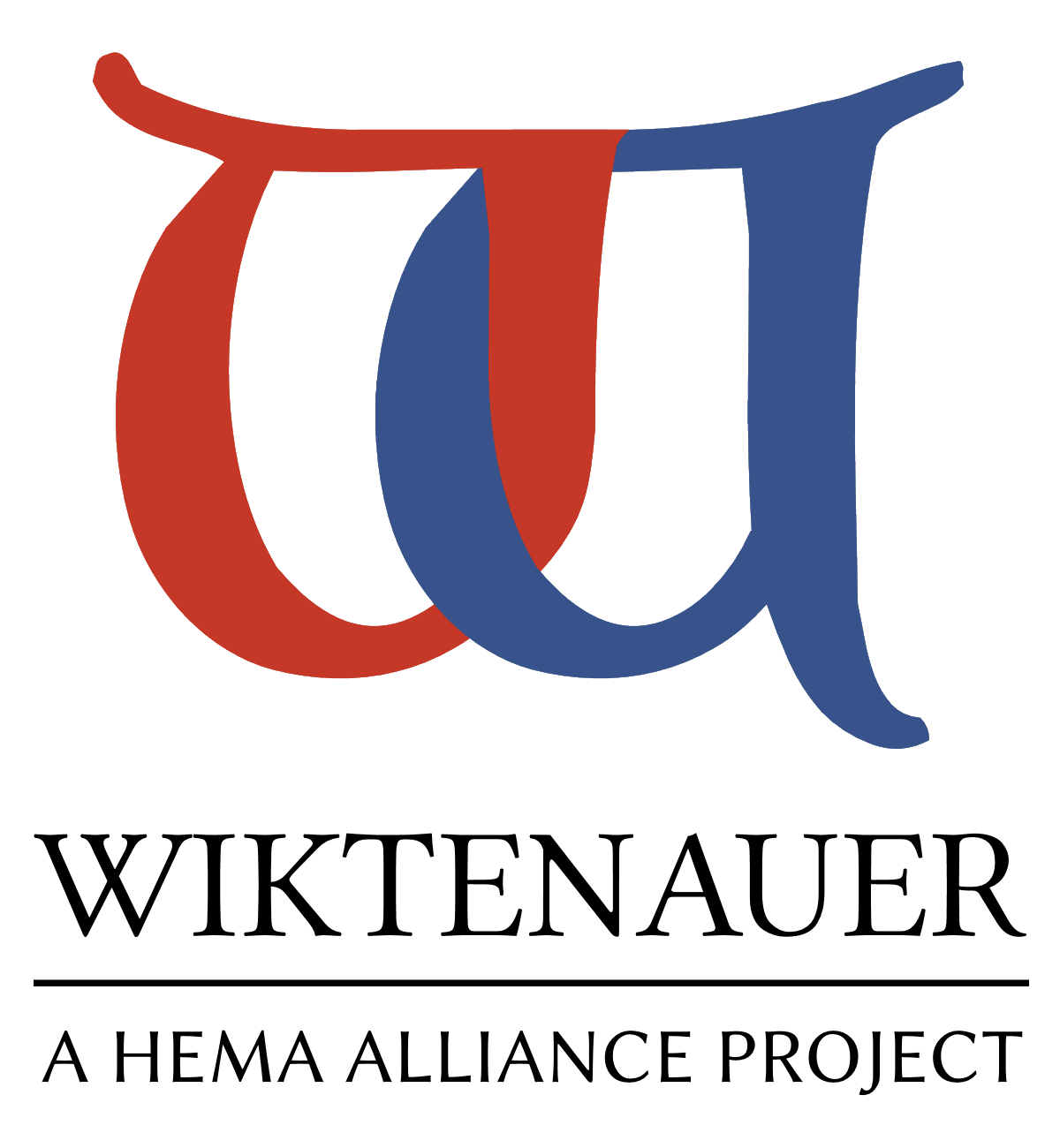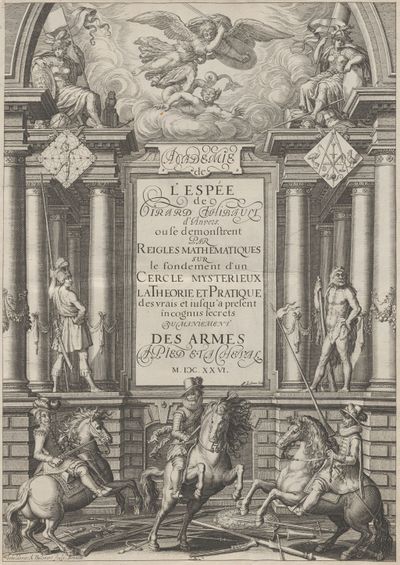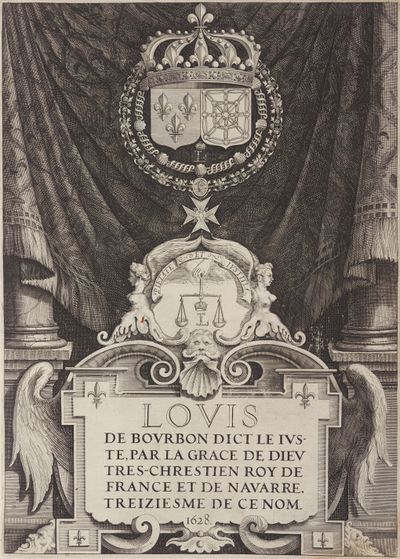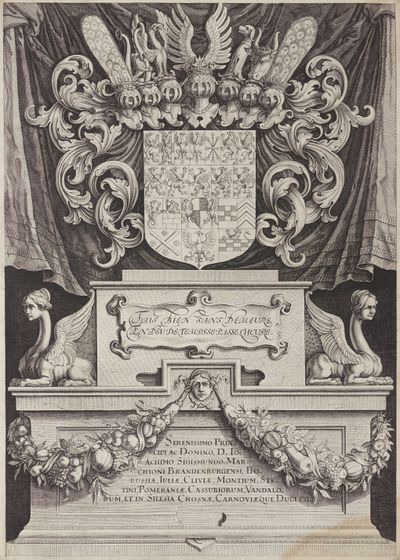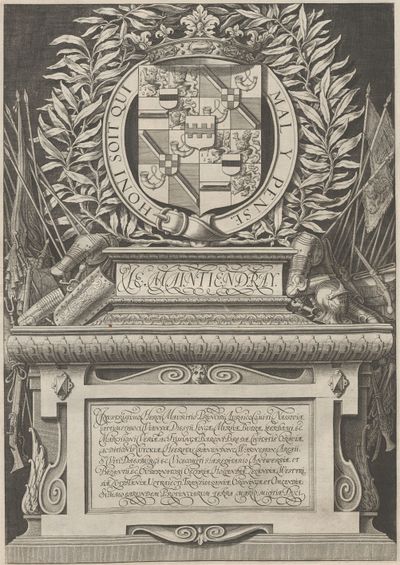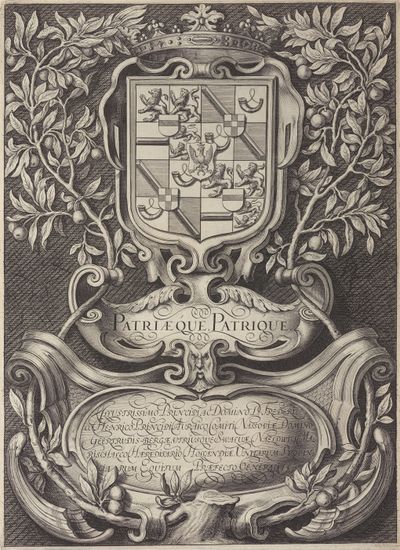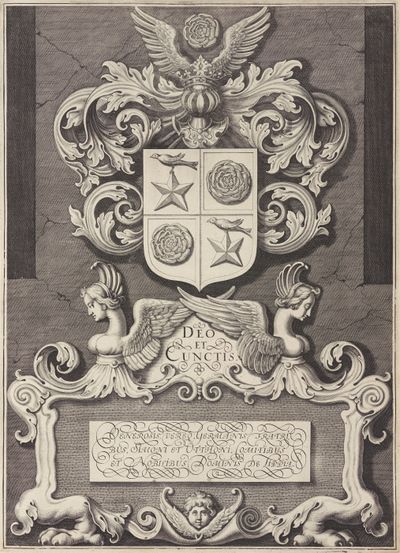|
|
You are not currently logged in. Are you accessing the unsecure (http) portal? Click here to switch to the secure portal. |
Difference between revisions of "Girard Thibault d'Anvers"
| (2 intermediate revisions by the same user not shown) | |||
| Line 50: | Line 50: | ||
Although initially met with skepticism, Thibault convinced his fellow Dutch fencing masters, including Johannes Damius of Haarlem, Dirck van Stervergen of Leiden, Cornelis Cornelisz van Heusden of Amsterdam, and Thibault's former teacher Lambert von Someron.<ref name="Verwey, Herman Fontaine 1978 p.290"/> | Although initially met with skepticism, Thibault convinced his fellow Dutch fencing masters, including Johannes Damius of Haarlem, Dirck van Stervergen of Leiden, Cornelis Cornelisz van Heusden of Amsterdam, and Thibault's former teacher Lambert von Someron.<ref name="Verwey, Herman Fontaine 1978 p.290"/> | ||
| + | |||
In 1615, Thibault was invited to the court at Cleves and left Amsterdam, where he once again demonstrated his system successfully.<ref>de la Verwey, Herman Fontaine. "Gerard Thibault and his Academie de l'Espée," Quaerendo VIII (1978) p.294</ref> Over the next several years, Thibault traveled from Cleves, Amsterdam, to Spain, back to Amsterdam, and finally to Leiden in 1622.<ref>de la Verwey, Herman Fontaine. "Gerard Thibault and his Academie de l'Espée," Quaerendo VIII (1978) pp.294-296</ref> There, Thibault studied mathematics at Leiden University.<ref name="Verwey, Herman Fontaine 1978 p.296">de la Verwey, Herman Fontaine. "Gerard Thibault and his Academie de l'Espée," Quaerendo VIII (1978) p.296</ref> It is unclear whether Thibault taught his system at the university.<ref name="Verwey, Herman Fontaine 1978 p.296"/> It is during his time in Leiden that Thibault likely began working on ''Academie de l'Espée'' and employed a team of sixteen master engravers.<ref>de la Verwey, Herman Fontaine. "Gerard Thibault and his Academie de l'Espée," Quaerendo VIII (1978) pp.296, 310</ref> | In 1615, Thibault was invited to the court at Cleves and left Amsterdam, where he once again demonstrated his system successfully.<ref>de la Verwey, Herman Fontaine. "Gerard Thibault and his Academie de l'Espée," Quaerendo VIII (1978) p.294</ref> Over the next several years, Thibault traveled from Cleves, Amsterdam, to Spain, back to Amsterdam, and finally to Leiden in 1622.<ref>de la Verwey, Herman Fontaine. "Gerard Thibault and his Academie de l'Espée," Quaerendo VIII (1978) pp.294-296</ref> There, Thibault studied mathematics at Leiden University.<ref name="Verwey, Herman Fontaine 1978 p.296">de la Verwey, Herman Fontaine. "Gerard Thibault and his Academie de l'Espée," Quaerendo VIII (1978) p.296</ref> It is unclear whether Thibault taught his system at the university.<ref name="Verwey, Herman Fontaine 1978 p.296"/> It is during his time in Leiden that Thibault likely began working on ''Academie de l'Espée'' and employed a team of sixteen master engravers.<ref>de la Verwey, Herman Fontaine. "Gerard Thibault and his Academie de l'Espée," Quaerendo VIII (1978) pp.296, 310</ref> | ||
| Line 56: | Line 57: | ||
== Treatise == | == Treatise == | ||
| − | The ''[[Academie de l'Espée (Girard Thibault d'Anvers)|Academie de l'Espée]]'' (1630) is presented in two books. Book 1 consists of a short introduction, populated with | + | The ''[[Academie de l'Espée (Girard Thibault d'Anvers)|Academie de l'Espée]]'' (1630) is presented in two books. Book 1 consists of a short introduction, populated with the coats of arms of several nobles who apparently sponsored the publication, and then introduces training in the use of his system of swordplay. |
| − | |||
| − | |||
| − | + | Book 2 lacks an explanation of the complex frontispiece, and was incomplete at the time of his death, but what he does have shows how to use his style against other weapons then in use, including shields, two-handed swords, and firearms. | |
{{master begin | {{master begin | ||
| Line 224: | Line 223: | ||
PRIVILEGE | PRIVILEGE | ||
| − | The Estates General of the United Provinces of the Netherlands, have consented and granted, and do consent and grant to the | + | The Estates General of the United Provinces of the Netherlands, have consented and granted, and do consent and grant to the heirs of Giraldo Thibault, that be during the time of next thirty years to come, alone in these united Lands, affiliated lands and towns, full rights and privileges that they may print, sell, and distribute this treatise, engravings, instructions, knowlege, & exercises entitled “Academie de {{sc|Girard Thibault}} d'Anvers, ou se demonstrent d'un cercle myssterieus la theorie & praćticque des vrais, & justes à present ingcognus secrets du maniement de Armes à pied & à cheval.” |
Forbidding one and all within the jursdiction of these lands, to offer for sale copies of the aforesaid book for the aforsaid time of thirty years, directly or indirectly, in whole, or in part either greater or lesser, neither the imprint, nor the engravings, nor the explanations of the engravings. | Forbidding one and all within the jursdiction of these lands, to offer for sale copies of the aforesaid book for the aforsaid time of thirty years, directly or indirectly, in whole, or in part either greater or lesser, neither the imprint, nor the engravings, nor the explanations of the engravings. | ||
| Line 230: | Line 229: | ||
Upon pain of forfeture of all copies and payment of a fine of the sum of nine hundred guilders. | Upon pain of forfeture of all copies and payment of a fine of the sum of nine hundred guilders. | ||
| − | One third part thereof to be given to the officer who performed the arrest, the second third to the watchmen, and the remaining third to the aforesaid Girardo Thibault. | + | One third part thereof to be given to the officer who performed the arrest, the second third to the watchmen, and the remaining third to the aforesaid heirs of Girardo Thibault. |
Given in Graven-Hague this fifth of June Sixteen-Twenty-Seven. | Given in Graven-Hague this fifth of June Sixteen-Twenty-Seven. | ||
| Line 255: | Line 254: | ||
'''NOTICE CONCERNING''' the figures of this book.<br/><br/> | '''NOTICE CONCERNING''' the figures of this book.<br/><br/> | ||
| − | Because the reader shall find it strange that many of the images are not placed upon the ground, but are above or below the horizon, we think it best they be conceived of as paintings upon the walls; this being because of the unequal circles above the horizon compared to the ground, and for more convenient representation of the doctrine, & for easier intelligibility in a manner which does not extend perspectives. Thus in | + | Because the reader shall find it strange that many of the images are not placed upon the ground, but are above or below the horizon, we think it best they be conceived of as paintings upon the walls; this being because of the unequal circles above the horizon compared to the ground, and for more convenient representation of the doctrine, & for easier intelligibility in a manner which does not extend perspectives. Thus in Table 3, high on both sides, we see 4 men painted on the walls, & in Table 5 there are four pieces in the form of paintings in the middle of the masonry wall each with its own appropriately-sized circle. In Tables 6, 16, 21, 22, 25, & 28 we find painted canvasses & murals on the sides, and on the lower parts of the walls. In Tables 7 & 27 we understand they are made in the form of charts. In Table 19, a tapestry hangs in the middle, in which the doctrines are embroidered. The Tables 5, 8, 14, 17, 18, 20, 22, 25, 26, 27, 28, & 29 likewise have painted walls, but the most important parts are shown alive on the ground or as painting on the wall base, because we have put there the means to see how the position of the swords relates to the lines of the Circle in the form of shadows on the lower line or base. We can see the positions of the blades, on the ground of the circle, by which means the capability to work out the movements of the swords the figures have in their hands becomes quite easy. |
| | | | ||
'''AVERTISSEMENT SVR LA CONSI-'''deration des figures de ce livre. | '''AVERTISSEMENT SVR LA CONSI-'''deration des figures de ce livre. | ||
| Line 268: | Line 267: | ||
| width = 60em | | width = 60em | ||
}} | }} | ||
| − | {{main| Girard Thibault d'Anvers/ | + | {{main| Girard Thibault d'Anvers/Tables 1-11}} |
{{master end}} | {{master end}} | ||
| Line 275: | Line 274: | ||
| width = 60em | | width = 60em | ||
}} | }} | ||
| − | {{main| Girard Thibault d'Anvers/ | + | {{main| Girard Thibault d'Anvers/Tables 12-22}} |
{{master end}} | {{master end}} | ||
| Line 282: | Line 281: | ||
| width = 60em | | width = 60em | ||
}} | }} | ||
| − | {{main| Girard Thibault d'Anvers/ | + | {{main| Girard Thibault d'Anvers/Tables 23-33}} |
{{master end}} | {{master end}} | ||
| Line 289: | Line 288: | ||
| width = 60em | | width = 60em | ||
}} | }} | ||
| − | {{main| Girard Thibault d'Anvers/ | + | {{main| Girard Thibault d'Anvers/Tables 34-46}} |
{{master end}} | {{master end}} | ||
Latest revision as of 19:04, 24 November 2025
| Girard Thibault d'Anvers | |
|---|---|
 | |
| Born | 1574 |
| Died | 1629 |
| Occupation | Fencing master |
| Nationality | Dutch |
| Movement | La Verdadera Destreza |
| Influences | |
| Genres | Fencing manual |
| Language | French |
| Notable work(s) | Academie de l'Espée (1630) |
Girard Thibault d'Anvers (ca. 1574–1629)[1] was a 17th century Dutch fencing master and author of the 1628 rapier manual Academie de l'Espée, one of the most detailed and elaborate sources ever written on fencing. Details about Thibault's life are sparse and what we know is based on his book and his album amicorum.[2] The latter contains handwritten notes and celebratory poems from Thibault's friends, relatives, pupils, and colleagues, included among whom are several contemporary fencing masters.[3]
Thibault was born in or around 1574 in Antwerp, son of Hendrick Thibaut and Margaretha van Nispen.[4] Although his father used the surname "Thibaut," Girard used the French form "Thibault."[4] Hendrick Thibaut came from a well-known family in Ypres, living in Ghent and Antwerp before going into exile in the northern Netherlands.[4] Henrick's eldest son, Christiaen, founded the noble family Thibaut van Aegtekerke.[5]
Thibault first studied fencing in Antwerp under Lambert van Someron, who taught between the years of 1564 and 1584.[6] In 1605, Thibault was a wool merchant in Sanlúcar de Barrameda, south of Seville on the Guadalquivir river, and the hometown of Jerónimo Sánchez de Carranza.[2] There, he took an interest in fencing, studying the Spanish rapier system of Destreza.[2]
Thibault left Spain to return to the Netherlands, and was in Amsterdam as early as 1610.[2] In or around 1611, he presented his system to an assembly of Dutch masters at a competition in Rotterdam.[7] Thibault won first prize, earning an invitation to the court of Prince Maurice of Nassau, where the Prince observed Thibault's system in a multi-day demonstration.[6]
Although initially met with skepticism, Thibault convinced his fellow Dutch fencing masters, including Johannes Damius of Haarlem, Dirck van Stervergen of Leiden, Cornelis Cornelisz van Heusden of Amsterdam, and Thibault's former teacher Lambert von Someron.[6]
In 1615, Thibault was invited to the court at Cleves and left Amsterdam, where he once again demonstrated his system successfully.[8] Over the next several years, Thibault traveled from Cleves, Amsterdam, to Spain, back to Amsterdam, and finally to Leiden in 1622.[9] There, Thibault studied mathematics at Leiden University.[10] It is unclear whether Thibault taught his system at the university.[10] It is during his time in Leiden that Thibault likely began working on Academie de l'Espée and employed a team of sixteen master engravers.[11]
Thibault died in 1629, a year before his masterpiece was finally published (despite the date on the title page of 1628, it was not published until 1630).[12]
Contents
Treatise
The Academie de l'Espée (1630) is presented in two books. Book 1 consists of a short introduction, populated with the coats of arms of several nobles who apparently sponsored the publication, and then introduces training in the use of his system of swordplay.
Book 2 lacks an explanation of the complex frontispiece, and was incomplete at the time of his death, but what he does have shows how to use his style against other weapons then in use, including shields, two-handed swords, and firearms.
| Illustrations | Draft Translation by Bruce G. Hearns |
First Edition (1626-30) Transcribed by Bruce G. Hearns |
|---|---|---|
|
Academy of the Sword by Girard Thibeault of Antwerp, wherein is demonstrated by means of mathematical rules, upon the foundation of the mysterious Circle, the Theory and Practise of the true and, until present, unknown secrets of the handling of arms both on foot and on horseback. 1628 |
[Ttl] Academie de L' ESPÉE de Girard Thibault d'Anvers ou se demonstrent Par Reigles mathematiques sur le fondemont d'un Cercle mysterieux la Theorie et Pratique des vrais et iusq'a present incognus secrets du maniement DES ARMES a Pied et a Cheval. Ⅿ. ⅠↃⅭ. ⅩⅩ ⅥⅠⅠ. | |
|
In tranquil reason, not impatient in his work, leads us courageously along his meandering path. Girard Thibault of Antwerp Rejoice. Patience endures. |
[ⅲ] TRANQUILLA RATIO, NEC SUI IMPATIENS LABOR, MODUM EVAGANTI PRÆSTRUIT FEROCIÆ. Girard Tibault d'Anvers Gaudet Patientia duris | |
|
To the most august, most high, most powerful, high, magnificent Emperors, Kings, Princes, Dukes, Counts, and all other Lords and noble Teachers and Amateurs, of the most noble science of handling Arms |
[ⅴ] Aux TRESAUGUSTE, TRESHAULTS, TRESPUISSANTS, TRESILLUSTRES, HAUTES, MAGNFIQUES, EMPEREUR ROYS PRINCES DUCS COMTES ET TOUTS AUTRES SEIGNEURS ET NOBLES Fauteurs & Amateurs DE LA TRESNOBLE SCIENCE de Manier les Armes. | |
[ⅵ] IN NOB. ET EXIMII VIRI D. GERARDI THIBAULTII Gladiatoriam artem, symbolo ac praemio AB ILLUSTRISSIMO PRINCIPE MAVRITIO à NASSAU, &c. Donatam. INter se geminas ferro concurrere dextras, D. Heinsius. | ||
|
Louis de Bourbon, called the Just, by grace of God, most-Christian King of France and Navarre, thirteenth of this name. 1628 |
LOVIS DE BOVRBON DICT LE IUSTE PAR LA GRACE DE DIEV TRES-CHESTIEN ROY DE FRANCE ET DE NAVARRE. TREIZIESME DE CE NOM 1628 | |
|
To the valiant heart, nothing is impossible. Arms and sundry titles of Georg Wilhelm (1595–1640) of the House of Hohenzollern, Elector of Brandenburg and Duke of Prussia from 1619. |
Au coeur vaillant rien n'est impossible Serenissimo Principi ac Domino Domino Georgio Guilermo Marchioni Brandenburgensi S. Romani imperii Archicamerario et Electori; Borussiæ, Iuliæ, Cliviæ, Montium Stetini, Pomeraniæ, Cassubiorum, Vandalorum et in Silesia Crosnæ, Carnovi, æ’que Duci Burggravio Norimbergensi Principi Rugiæ. Comiti Marchiæ, ac Ravensbergi. Dynatæ Ravenstein y, &c. | |
|
Work well without pause, and the hours pass quickly. Arms and sundry titles of Johann Sigismund (1572–1619), Elector of Brandenburg (1608–1619) of the House of Hohenzollern, Elector of Brandenburg from 1608 and Duke of Prussia, through his wife Anna, from 1618. |
Fais biens sans demeure, et peu de temps se passe l’heure Serenissimo Principi ac Domino Do. Io. Achimo Sigismundo. Marchioni Brandenburgensi, Borussiæ, Iuliæ, Cliviæ, Montium Stetini, Pomeraniæ, Cassubiorum, Vandalorum, et in Silesia Crosnæ, Carnoviæ ‘que Ducter | |
|
Everything with God, Nothing without Reason. Arms and title of Christian (the Elder) (1566–1633), Duke of Brunswick and Lunenbourg. |
Tout Avec Dieu, Rien Sans Raison Serenissimo Principi ac Domino Domino Christiano Duci Brunswicensi et Lunenburgensi | |
|
(Order of the Garter about the arms – Shame to him who evil thinks) I maintain Arms and titles of Maurice of Nassau (1567–1625), who became Prince of Orange in 1618. |
(Order of the Garter about the arms – Honi soit qui mal y pense) Ie Maintiendray Ilustrissimo Heroi Muritio Principia Auraico, Comiti Nassoviæ, Cattimeliboci, Viandæ, Diestii, Lingæ, Mursiæ, Bueræ, Leerdami, &c. Marchioni Veriæ, ac Frissinge Baroni Bredæ. Civitatis Graviæ, ac ditionis Cuyckiæ, Herrstas, Cranendonc, Warneston, Arlaii, Svti Viti. Daesburgi &c. Vicecomiti Hæreditario Antwerpiæ, et Bizantii &c. Gubernatoi Geldriæ, Hollandie,, Lelandiæ, Westfrisiæ Zutphaniæ, Ultraiecti, Transisalaniæ, Groninge et Omlandiæ; Summo earundem Provinciarum terra mario, misitiæ Duci | |
|
Of the homeland. With the homeland. Arms and titles of Frederick Henry (1584–1647), Prince of Orange (1625–1647) |
Patriæ. Patrique Illustrissimo Principi ac Domino D. Frederico Henrico Principi Auraico. Comiti Nassoviæ, Dominio Geertrudis-bergæ, utriusque Swaluæ, Naeldwici. Marischalco Hæreditario Hollandiæ, Unitarum Provinciarum Equitum Præfecto Generali &c. | |
|
Constant Arms & titles of Ernest Casimir (1573–1632), Count of Nassau-Dietz (1606–1632) |
Constant Illust[rissi]mo Principi Ernesto Casimiro Comiti Nassoviæ, Catimeliboci, Viandæ, Dies Rii; Domino Bilsteiniæ, Castrorum Unitarum Provenciarum Praefecto; Gubernatori Frisiæ &c. | |
|
God and all Dedication and Arms of Simon VII (1587–1627), Count of Lippe (1613–1627), and his brother Otto (1589–1657), Count of Lippe-Brake (1621–1657) |
Deo et Cunctis Generosis vere’q Germanis Fratribus, Simoni et Otthoni, Comitibus et Nobisibus Dominis de Lippia | |
|
Nothing without God Arms of Stephan Gans, Baron Putlitz |
Rien sans Dieu Nobilissimo, Generosissimoq; Heroi Domino Stephano Gans, Libero Baroni PotlitzI, Nec non Wolffshagiæ, turmæ equestris sub ductu et moderamine Illustrissimi Principis Auraici præfecto | |
|
GRANT OF PRIVILEGE BY THE KING OF FRANCE By grace and privilege of the King, it has been permitted and granted to Gerard Thibault native of Antwerp, to print, sell, and distribute the present book and figures, in such character and volume as to him seems fit, in all the Kingdoms, lands, and holdings of his Majesty during a period of nine years counting from the day he shall have it printed, with all protections from all persons of whatever quality and condition they may be, to sell and distribute the said book, in part or portion thereof, whether a lithograph, woodcut, etched plate, stolen or counterfeit, or to sell the said figures alone or with summary of what they represent, either separately or jointly, on pain of contravention of loss of goods and five thousand pounds fine, half applicable to his Majesty, and the other to the said Thibault; who, moreover carries full letters to this effect, given in Paris, the XXI Day of December, in the year of grace one thousand six hundred and twenty and in fourth of the reign of the said King. Signed by the King in his Council and sealed with the great seal of his Majesty in yellow wax on a ribbon. |
EXTRAICT DU PRIVILEGE DU ROY DE FRANCE Par grace & privilege du Roy, il a esté permis & oćtroyé à Gerard Thibault natif d'Anvers, d'imprimer vendre & debiter le present livre & figures, en tel charaćter & volume que bon luy semblera, par tous les Royaumes pays terres & Seigneuries de sa Majesté, pandant le temps de neuf ans à compter du jour qu'il sera achevé d'imprimer: avec deffences à toutes personnes de quelque qualité & condition qu'ils soyent, de vendre & debiter ledićt livre part ou portion d'iceluy, avec lesdites figures seuls ou sans icelles, soit taille douce, de bois, d’eau forte, de le pocher ou contrefaire, ou vendres lesdites figures seules ou avec somaire de ce qu'elles representent, soit separemant ou conjoinćtment, sur pene au contrevenant de perte des exemplaires, & de cincq mille livres d'amande; moitie applicable à sa Majesté, & l'autre audićt Thibault; comme plus a plein est porté aux lettres sur ce obtenues, données à Paris le XXI. Jour de Decembre, l'an de grace mil six cent vengt, & du regne du dićt Seigneur le quatiesme. Seignées par le Roy en son Conseil Perrochet, & scellees du grand seau de sa Maiesté en cire jaune à queue pendant. | |
|
PRIVILEGE The Estates General of the United Provinces of the Netherlands, have consented and granted, and do consent and grant to the heirs of Giraldo Thibault, that be during the time of next thirty years to come, alone in these united Lands, affiliated lands and towns, full rights and privileges that they may print, sell, and distribute this treatise, engravings, instructions, knowlege, & exercises entitled “Academie de Girard Thibault d'Anvers, ou se demonstrent d'un cercle myssterieus la theorie & praćticque des vrais, & justes à present ingcognus secrets du maniement de Armes à pied & à cheval.” Forbidding one and all within the jursdiction of these lands, to offer for sale copies of the aforesaid book for the aforsaid time of thirty years, directly or indirectly, in whole, or in part either greater or lesser, neither the imprint, nor the engravings, nor the explanations of the engravings. Upon pain of forfeture of all copies and payment of a fine of the sum of nine hundred guilders. One third part thereof to be given to the officer who performed the arrest, the second third to the watchmen, and the remaining third to the aforesaid heirs of Girardo Thibault. Given in Graven-Hague this fifth of June Sixteen-Twenty-Seven. Gaspar van Vosgbergen. By order of the President of the Estates-General. I. van GOCH. |
PRIVILEGIE De Staten Generael der Vereenighde Nederlanden, hebben gheconsenteert ende gheoćtroyeert, consenteren ende oćtoyeren by desen d'erfghanamen van Giraldo Thibault, dat sy gheduerende den tijdt van dertich eerst-ckomende Iaren, alleene in dese vereenighde Landen, gheassocieerde Landtschappen ende Steden, sullen moghen Drucken, doen Drucken, ende uytgheven seeckere Wapen-kunst, bestaende in Figuren, met regulen, aenwijsinghen ende leer-sstucken, gheinsituleert Academie de GIRARD THIBAULT d'Anvers, ou se demonstrent d'un cercle myssterieus la theorie & praćticque des vrais, & justes à present ingcognus secrets du maniement de Armes à pied & à cheval. Verbiedende allen ende een yeghelijck Inghesetenen van dese Landen, de voorschreven Wapen-konste binnen den voorschreven tijdt van dertich Iaren, direćtelijck ofte indirećtelijck, in't geheel, ofte ten deele, in't groot oste in't kleyne, na te Drucken, ende uyt te gheven, oste elders na ghedruct, hier te Lande te brenghen om verkost te werden, by verbeurte van alle de na-ghedruckte exemplaren, ende daer-en-boven van de somme van neghen hondert guldens; 'tappliceren een derdendeel daer van ten behoeve van Officier die de calangie doen sal, het tweede derdendeel ten behoeve van de armen, ende het resterend derdendeel ten behove van de voorschreven erfghenamen van Girardo Thibault. Ghedaen in s'Graven-Haghe op den vijfden Iunij sesthein-hondert seven en twintich. Gaspar van Vosberghen Vt. Ter ordonnantie van de Hooch-ghemelte Heeren Staten Generael. I. van GOCH | |
|
NOTICE CONCERNING the figures of this book. Because the reader shall find it strange that many of the images are not placed upon the ground, but are above or below the horizon, we think it best they be conceived of as paintings upon the walls; this being because of the unequal circles above the horizon compared to the ground, and for more convenient representation of the doctrine, & for easier intelligibility in a manner which does not extend perspectives. Thus in Table 3, high on both sides, we see 4 men painted on the walls, & in Table 5 there are four pieces in the form of paintings in the middle of the masonry wall each with its own appropriately-sized circle. In Tables 6, 16, 21, 22, 25, & 28 we find painted canvasses & murals on the sides, and on the lower parts of the walls. In Tables 7 & 27 we understand they are made in the form of charts. In Table 19, a tapestry hangs in the middle, in which the doctrines are embroidered. The Tables 5, 8, 14, 17, 18, 20, 22, 25, 26, 27, 28, & 29 likewise have painted walls, but the most important parts are shown alive on the ground or as painting on the wall base, because we have put there the means to see how the position of the swords relates to the lines of the Circle in the form of shadows on the lower line or base. We can see the positions of the blades, on the ground of the circle, by which means the capability to work out the movements of the swords the figures have in their hands becomes quite easy. |
AVERTISSEMENT SVR LA CONSI-deration des figures de ce livre. Pource que le spećtateur trouveroit estrange, que plusieurs Images ne sont fixement posées sur le fondement, taut au dessus qu'au dessoubs de l'Horison: nous avons touvé bon de l'advertir, qu'il les faut concevoir comme estant despeintes aux murailles; cela estant fait à cause des Cercles inegaux tant au dessus de l'Horison que sur le plan, pour la representation plus commode de la doćtrine, & pour l'intelligence plus facile du commun qui n'entend les perspećtives: ainsi au Tableau 3. au dessus d'un & d'autre costé sont despeints 4. hommes aux parois, & en la Table 5. il y à quatre pieces en forme de peinture au millieu de la muraille ou massonerie, desquels Cercles chascun sussit pour soy, & es Tables 6. 16. 21. 22. 25. & 28. au millieu des toilles peinturées, & au costez sont despeintes à la paroy, es Tables 7. & 27. faut entendre que cela est fait en forme de chartes, & en la Table 19. un tapi tendu ou pendu au millieu, dans lesquel les doćtrines sont tissues, & es Tables 5. 8. 14. 17. 18. 20. 22. 25. 26. 27. 28. 29. de mesme despeint aux murailles, mais les premieres pieces se demonstrent plus vivement sur le fond ou base que les autres, car la se voit la façon des accords des espées & leur operation par les lignes du Cercle; pour ce que en forme d'Esquierre de la ligne Inferieure ou base, on trouve un accord des lames, fait au fond ou Cercle, par lequel le jugement des operations mouvantes des espées que les figures tiennent en main, est rendu tres-facile. |
For further information, including transcription and translation notes, see the discussion page.
| Work | Author(s) | Source | License |
|---|---|---|---|
| Images | courtesy of Reinier van Noort | Thibault.zip | |
| Translation | Bruce G. Hearns | Wiktenauer | |
| Transcription | Bruce G. Hearns | Wiktenauer |
Additional Resources
- Howden, Matthew. "Comparison of Thibault’s Circle and the Leiden Circle". Sworded Contemplations. April, 2008. Retrieved 08 February 2015.
The following is a list of publications containing scans, transcriptions, and translations relevant to this article, as well as published peer-reviewed research.
- Fontaine Verwey, Herman de la (1978). "Gerard Thibault and his Academie de l'Espée." Quaerendo 8(4): 283-319. doi:10.1163/157006978X00188.
- Majár, János; Zoltán Várhelyi (2014). "Thibault and Science I. Measure, Distances and Proportions in the Circle." Acta Periodica Duellatorum 2(1): 67-104. doi:10.1515/apd-2015-0014.
- Pascha, Johann Georg; Heinrich von und zum Velde (2018). Proper Description of Thrust-Fencing with the Single Rapier. Trans. by Reinier van Noort; Jan Schäfer. Glasgow: Fallen Rook Publishing. ISBN 978-0-9934216-7-9.
- Saviello, Julia (2018). "Girard Thibault: Bewegung in Harmonie mit dem Körper (1630)." Schönheit ― Der Körper als Kunstprodukt: Kommentierte Quellentexte von Cicero bis Goya: 287-300. Ed. by Romana Sammern; Julia Saviello. Heidelberg: Arthistoricum.net. doi:10.11588/arthistoricum.425.c5753.
- Thibault, Gérard (2006). Academy of the Sword. Trans. by John Michael Greer. Highland Village: Chivalry Bookshelf. ISBN 978-1-891448-40-9.
- Thibault, Gérard (2017). Academy of the Sword. Trans. by John Michael Greer. London: Aeon Books. ISBN 978-1-190465-884-9.
- Thomas, Rémy (2022). Pratiques et apprentissage de l'escrime dans l'Academie de l'espée de Girard Thibault d'Anvers (1630) [Unpublished thesis]. Liège: Université de Liège. http://hdl.handle.net/2268.2/15440
- Van Noort, Reinier; Jan Schäfer (2017). "An analysis and comparison of two German thrust-fencing manuscripts." Acta Periodica Duellatorum 5(1): 63-74. doi:10.36950/apd-2017-002.
References
- ↑ de la Verwey, Herman Fontaine. "Gerard Thibault and his Academie de l'Espée," Quaerendo VIII (1978) pp.288, 297
- ↑ 2.0 2.1 2.2 2.3 de la Verwey, Herman Fontaine. "Gerard Thibault and his Academie de l'Espée," Quaerendo VIII (1978) p.289
- ↑ de la Verwey, Herman Fontaine. "Gerard Thibault and his Academie de l'Espée," Quaerendo VIII (1978) p.297
- ↑ 4.0 4.1 4.2 de la Verwey, Herman Fontaine. "Gerard Thibault and his Academie de l'Espée," Quaerendo VIII (1978) p.288
- ↑ de la Verwey, Herman Fontaine. "Gerard Thibault and his Academie de l'Espée," Quaerendo VIII (1978) p.288-289
- ↑ 6.0 6.1 6.2 de la Verwey, Herman Fontaine. "Gerard Thibault and his Academie de l'Espée," Quaerendo VIII (1978) p.290
- ↑ de la Verwey, Herman Fontaine. "Gerard Thibault and his Academie de l'Espée," Quaerendo VIII (1978) pp.289-290
- ↑ de la Verwey, Herman Fontaine. "Gerard Thibault and his Academie de l'Espée," Quaerendo VIII (1978) p.294
- ↑ de la Verwey, Herman Fontaine. "Gerard Thibault and his Academie de l'Espée," Quaerendo VIII (1978) pp.294-296
- ↑ 10.0 10.1 de la Verwey, Herman Fontaine. "Gerard Thibault and his Academie de l'Espée," Quaerendo VIII (1978) p.296
- ↑ de la Verwey, Herman Fontaine. "Gerard Thibault and his Academie de l'Espée," Quaerendo VIII (1978) pp.296, 310
- ↑ Thibault, Gerard. Academy of the Sword. Trans. John Michael Greer. Highland Park, TX: The Chivalry Bookshelf, 2006. pp 1-2.
|
|||||||||||||||||||||||||||
